The Waterloo Battlefield is located 15 kilometers (9 miles) south of Brussels in Belgium and covers an area of 5 square kilometers (2 square miles). It is where the famous Battle of Waterloo was fought on 18 June 1815 between the French forces of Napoleon Bonaparte and the Allied armies led by the Duke of Wellington and Field Marshal Blücher. The Waterloo Battlefield today retains much of the rolling, rural topography it had in 1815, allowing visitors to reflect on how the landscape shaped the course of the battle. The area evokes memories of the epic fight, including the strategic crossroads of La Belle Alliance, Hougoumont Farm, which saw heavy fighting, and the restored farmhouse of La Haie Sainte, which was a focal point for French assaults.
The 40-meter (131-foot) tall Lion’s Mound in Waterloo Battlefield is its most famous monument. It was constructed at the spot where the Prince of Orange was wounded, and its bronze lion statue gazes over the battlefield. The excellent visitor center provides interactive exhibits and audio-visual shows about the background, armies, commanders, and timeline of events during that fateful day in 1815. The Waterloo Battlefield lets visitors trace the movements of forces and consider how geography influenced tactics. Placards and memorials mark where heroic acts occurred, or leaders lost their lives. The Papelotte, La Haie, and Smohain museums provide more insights into different phases of the fighting. For history lovers, walking in the footsteps of Wellington, Napoleon, and their armies across these Belgian fields offers a reflection on how the fate of Europe and the world was irreversibly changed in a matter of hours at the Waterloo Battlefield.
What is Battle of Waterloo?
The Battle of Waterloo was fought on Sunday 18 June 1815 near the town of Waterloo in modern Belgium, about 15 kilometers (9 miles) south of Brussels. It marked the decisive defeat of Napoleon Bonaparte, ending 23 years of recurrent warfare between France and other powers of Europe.
The armies involved were Napoleon’s Armée du Nord, a multinational force under the Duke of Wellington, and a Prussian army led by Field Marshal Blücher. Wellington’s force included British, Dutch, Belgian, Hanoverian and German troops totaling around 68,000 men. Blücher had about 50,000 Prussians. Napoleon had 72,000 French troops, mostly veterans. Wellington took up a strong defensive position on a ridge south of Waterloo village. His forces lined the crest behind a sunken road, with garrisons in the fortified farms of Hougoumont on the right and La Haye Sainte on the left. Blücher’s Prussians were to the east. Napoleon’s army formed up opposite Wellington. The battle opened with French attacks on Hougoumont which escalated into an all-day fight drawing in reserves. D’Erlon’s corps then assaulted Wellington’s left but was driven back by British infantry and cavalry charges. A French cavalry attack was also repulsed. However, Ney’s renewed assault captured La Haye Sainte, exposing Wellington’s center.
At this crisis, Blücher’s Prussians arrived to attack the French right flank. Napoleon committed his Imperial Guard to break Wellington’s weakened center, but they failed to do so. As the Prussians pushed in, Wellington went on the offensive and the French army collapsed and fled under Allied pursuit.
Waterloo was a crushing defeat for Napoleon, forcing him to abdicate days later. It ended the Napoleonic Wars and 23 years of conflict involving France and the other European powers. The 1815 peace settlement laid the foundation for four decades of international stability in Europe.
The battlefield today retains its rural character though the land has been altered. The key locations of Hougoumont, La Haye Sainte and the Lion Mound monument are preserved. Archaeological investigations have uncovered scant human remains, likely because bones were collected after the battle for fertilizer. Waterloo secured Wellington’s reputation as a great commander. The steadfast British infantry squares that repulsed French cavalry charges entered legend. The battle demonstrated the vital importance of the Anglo-Prussian alliance against Napoleon. For later generations, Waterloo became a symbol of an epochal victory ushering in a new era of peace.
What is Waterloo Battlefield?
The battlefield of Waterloo is located just south of Waterloo village in Belgium, about 15 km (9 miles) south of Brussels. It retains its rural agricultural character, though the landscape has been altered over the years. Key locations from the 1815 battle like the fortified farms of Hougoumont and La Haye Sainte still stand and are preserved as historic sites. The ruins of Mont-Saint-Jean farm, Wellington’s command post, also remain. The most prominent landmark is the Lion’s Mound, an artificial hill constructed in 1820 with soil from the battlefield topped by a lion statue. It provides views across the landscape.
Other monuments and markers indicate the positions of forces involved and highlight significant locations. There is a panorama depicting the battle inside the Lion’s Mound. Parts of the terrain, especially the Anglo-Allied ridge line, have been changed over time. The sunken lane used by Wellington is less pronounced. Though thousands were killed at Waterloo, archaeology has uncovered limited human remains. Bones were likely removed after the battle to make fertilizer. The site draws hundreds of thousands of visitors each year interested in the history of Waterloo and Napoleonic warfare. Reenactments are also staged. The battlefield was designated a UNESCO World Heritage site in 2015 given its significance and level of preservation.
What are the main sites to explore in Waterloo Battlefield?
Listed below are the main sites visitors should explore in Waterloo Battlefield.
- Duke of Wellington’s Headquarters
- Lion’s Mound Hamlet
- Napoleon’s Headquarters
1. Duke of Wellington’s Headquarters
This is where the Duke of Wellington from Great Britain spent the night before and after the Battle of Waterloo on the 17 & 18 June 1815. You can still see the room where he slept and the desk where he wrote his report of victory on the battlefield.
When buying your ticket, you get an audio guide that tells you all about the battle in chronological order and follows the layout of the rooms.
The museum is housed in a rather old building not far from the battlefield which is much bigger than you’d expect at first glance. A lot of original items are on display, as well as detailed maps of the movements during the battle that summer day in 1815.
2. Lion’s Mound Hamlet
The Waterloo lion was inaugurated in 1826 on the spot on the battlefield where William II of the Netherlands (The Prince of Orange) was wounded and knocked off his horse. It’s a 41-meter monument made from the earth of the Waterloo battlefield, with a cast-iron lion statue, the lion of Waterloo, weighing 28 tons on top of it.
You can climb the 226 steps up Lion’s Mound to get a great view over the former battlefield where over 250, 000 men fought in 1815. If it’s not foggy, that is…
For someone with a fear of heights, 41 meters is pretty high, but I hadn’t really thought of that until I’d already started climbing Lion’s Mound. Even when I felt that famous fear creeping up on me, I didn’t return. I was in Waterloo and climbing the Lion’s Mound is just something you need to do.
I rushed up the stairs, eyes fixed on the steps, and definitely not taking any photos or filming. When I arrived at the top I was exhausted. I’d completely lost my breath and my legs were shaking. Partly because I practically ran up the steps, but partly, also because I’d been so afraid while going up.
Luckily you can sit on top of the mound as there are a couple of “steps” around the lion. So that’s what I did. After a while, I dared to look behind me and up, but I couldn’t even see the lion from there as it’s too high up.
I tried getting a view shots of the view (from the steps I was sitting on, no way that I was going to stand by the railing!) but it was too foggy that day to properly see very far.
After I was safely down, it was time for some movies. You need a special ticket to watch these unless you have the Pass 1815. The first movie is modern and a well-made summary of the events that had lead to the Battle of Waterloo and what happened on the Waterloo battlefield itself.
The second movie took place in another, more run-down room and consisted of fragments from the older movie “Waterloo” (1970), which tells the story of the Battle of Waterloo.
The last thing to do at the Waterloo battle site is the Panorama, a round building that shows a 110m round, 12m high, 360° fresco of the battle. It was painted in 1912 to celebrate the centenary of the battle and restored in 2008.
3. Napoleon’s Headquarters
Napoleon established his command post at the Caillou farmhouse, about 3 km (2 miles) behind the French front lines. This provided a good vantage point early in the battle. The modest whitewashed farmhouse allowed Napoleon to be near his reserves but still communicate with his forces on the ridge facing Wellington. As the battle progressed, the position was less effective as Napoleon could not directly observe the fighting unfolding below. Smoke and terrain obstructed views. Around midday Napoleon moved his headquarters forward to a position near La Belle Alliance inn, closer to the center of his line. The Caillou farmhouse is preserved as a museum today. Period furnishings and exhibits convey a sense of Napoleon’s spartan HQ during the battle. Guides in period uniforms provide information about Napoleon’s activities at Caillou, his officers, aides and generals who met him there. A stone marks the exact location from which Napoleon watched the opening stages of the battle and initiated the first French attacks. The Caillou farmhouse and surrounding area saw intense activity as Napoleon directed the earlier phases of the Waterloo campaign from this HQ.
Where is Waterloo Battlefield located?
The Waterloo Battlefield is located in Route du Lion 315, 1420 Braine-l’Alleud, Belgium. The battlefield is 15 kilometers (9 miles) south of Brussels and covers 5 square kilometers (2 square miles). It was fought on 18 June 1815 between the French army led by Napoleon Bonaparte and the allied armies commanded by the Duke of Wellington and Field Marshal Blücher. The battle marked the final defeat of Napoleon after his return from exile in Elba and is considered one of the most decisive battles in European history.
The Waterloo Battlefield today contains several memorials and museums that commemorate the battle, including the famous Lion’s Mound monument, the Wellington Museum, the Panorama painting of the battle, and the visitor center. The battlefield related to the fighting on 18 June 1815 can be explored, like the strategic crossroads of La Belle Alliance, Hougoumont farm, and La Haie Sainte farmhouse.
How can visitors get to Waterloo Battlefield?
There are several convenient transportation options for visitors to reach the Waterloo Battlefield site in Belgium. Firstly, the battlefield is located only 15 kilometers (9 miles) south of Brussels. Brussels is well connected by rail to cities across Belgium, France, Germany, and the Netherlands, and visitors can access the Waterloo Battlefield by taking a train from Brussels to the town of Braine-l’Alleud. There are direct train journeys from Brussels Central Station to Braine-l’Alleud, which take 25 minutes. After arriving, the battlefield is just a short taxi ride or bus trip away.
Secondly, for visitors driving their own car, Waterloo Battlefield is easily accessed via the E19 motorway, which connects Brussels to Mons. The drive from Brussels takes 30 minutes in normal traffic. There is parking available at the visitor center and monuments around the battlefield area. Lastly, there are guided tour buses to Waterloo Battlefield that also depart from Brussels. These full-day tours stop at key sites on the battlefield and provide context about the events of 18 June 1815. The major operators like City Wonders and Brussels City Tours offer these guided tours as a convenient option for visitors who prefer not to take public transport.
After arriving at the Waterloo Battlefield, free shuttle buses circulate visitors between the main monuments and museums in the area. These shuttle buses have stops at the visitor center, the Lion Mound, and the Hougoumont farmhouse.
What are the opening hours in Waterloo Battlefield?
The Waterloo Battlefield in Belgium has different opening hours depending on the site and the season. The Visitor Center is open daily from 9:30 am to 6:30 pm between April and September, and from October to March, opening hours are 10:00 am to 5:30 pm on weekdays and 9:30 am to 6:00 pm on weekends.
The Lion Mound monument is open daily from 9:30 am to 8:00 pm between April and September, and from October to March, it is open daily from 9:30 am to 5:30 pm. The Panorama Museum is open daily from 10:00 am to 6:00 pm, while the Hougoumont Farmhouse is open daily from 9:30 am to 6:00 pm between April and September and from 10:00 am to 5:30 pm from October to March.
It is recommended to visit the Visitor Centre first to get oriented and view the recommended walking routes that connect the various sites related to the 1815 Battle of Waterloo Battlefield, with audio guides for self-guided tours being available.
What are the ticket prices for Waterloo Battlefield?
There are various ticket options for visitors to the Waterloo Battlefield in Belgium. The basic entry ticket for the Visitor Center costs 5 € ($5.50, £4.50) and provides an overview of the battle and orientation to the site. The Lion’s Mound entry ticket costs 12.50 € ($13.75, £11), which allows access to climb the monument for panoramic views over the battlefield. There is a joint ticket for the Visitor Centre and Lion’s Mound, which costs 15 € ($16.50, £13.50).
There is also a Waterloo Battlefield Pass available for 27 € ($29.75, £24), which provides access to all the main sites – the Visitor Center, Lion’s Mound, Panorama Museum, and Hougoumont Farmhouse, which is valid for one year. Audio guides cost 6 € ($6.60, £5.40) and battlefield maps are 3 € ($3.30, £2.70). For guided tours, the prices are 15 € ($16.50, £13.50) for a 1.5-hour walking tour, 50 € ($55, £45) for a half-day minibus tour, and 95 € ($105, £85) for a full day tour including lunch, with discounted rates available for children, seniors, students, and families, while children under 6 get free entry.
Are there any tours available for Waterloo Battlefield?
Yes, there are guided tour options available for visitors wanting to explore the Waterloo Battlefield. Firstly, walking tours of the battlefield provide an up-close perspective and insights from knowledgeable guides. These tours last 1.5 hours and cost 15 € ($16.00, £13.06) per person. Visited sites include the Lion Mound, the Wellington Museum, Hougoumont Farmhouse, and the spot where Napoleon watched the battle. Secondly, minibus tours offer a driving overview of the Waterloo Battlefield, including commentary from guides. These half-day tours stop at the top highlights and cover more ground than walking tours. The prices are 50 €($53.33, £43.54) per person for a 3 to 4-hour minibus tour.
Thirdly, full-day tours are also available with lunch included and prices starting from 95 € ($101.32, £82.72) per person and last 7 to 8 hours. These tours provide the most in-depth experience with more time to immerse in the events of 1815. Lastly, there are some tour operators that offer Waterloo Battlefield tours, such as the Brussels City Tours, City Wonders, Brussels Sightseeing Tours, and Viator Tours, with private and custom tour options available.
It is recommended to book ahead as some tours have limited capacity. These tours generally depart from Brussels in the morning, with hotel pick-up options. There are also audio self-guided tours available to rent on-site for 6 € ($6.40, £5.22), which provides recorded commentary as visitors walk around at their own pace.
What is the highlight of a visit to Waterloo Battlefield for a tourist?
The Lion’s Mound is a top attraction in the Waterloo Battlefield, which is a 40-meter (131-foot) tall monument that has 226 steps leading to a view of the battlefield from the top. It is believed to be the location where the Prince of Orange was wounded during the fight, while the bronze lion statue atop the mound is a symbol of the Allied victory. The visitor center is also highly recommended as it provides an interactive and informative overview of the background, armies, commanders, and course of the battle through displays and audio-visual presentations, which helps visitors better understand and appreciate the various monuments and sites around the 5 square kilometer battlefield area. The strategic crossroads of La Belle Alliance, Hougoumont Farm, which saw intense fighting, the restored farmhouse of La Haie Sainte, and the Papelotte, La Haie, and Smohain museums covering different phases of the battle are also a place to enjoy and dive deeper into the past of the Waterloo Battlefield.
Is Waterloo Battlefield child-friendly?
Yes, the Waterloo Battlefield is child-friendly. Firstly, there are interactive exhibits and multimedia presentations at the Visitor Centre that can engage and teach children about historical events in an easy-to-understand way, such as short films, 3D models, and hands-on displays that make the battle come to life for kids. Secondly, climbing the Lion Mound is an adventurous highlight for children, especially walking up the 226 steps to enjoy the views from the monument’s summit can be an exciting physical challenge suitable for most ages. Thirdly, activities like scavenger hunts and quizzes based on clues around Waterloo Battlefield are available for families. These encourage children to explore the site in a playful way and learn while having fun. Fourthly, entry is free for children under 6 years old, and discounted rates for older kids are offered, making Waterloo Battlefield accessible for families budget-wise. Lastly, picnicking and letting kids run around the open fields is a nice way to take a break between visiting the historical monuments and museums.
What are the practical tips for visitors of Waterloo?
Find below some useful info if you plan on visiting Waterloo.
Wellington’s Headquarters
The address of Wellington’s Headquarters is Chaussée de Bruxelles 147, Waterloo. The Pass 1815 is a special pass giving you access to the Wellington Museum, the Lion’s Hamlet (including both films and the Panorama) and Musée du Caillou. For more information and to purchase a Pass 1815, you can also always go to the Tourist Information Center or “Maison du Tourisme” of Waterloo, which is located right across from the Wellington Museum.
Getting to Wellington’s Headquarters:
- by bus: from Brussels, take line W or line 365 and stop at Waterloo Église
- by train: take the train to Waterloo station, then follow Rue de la Station for 1 km
- by car: only 20 minutes from Brussels. Park for free behind the church and tourism office (across the street)
The Lion’s Mound Hamlet with films and Panorama
The Lion’s Mound Hamlet is located in Route du Lion 315, Waterloo.
Getting to Lion’s Mound Hamlet:
- by bus: take line W from Braine-l Alleud, Waterloo or Brussels. Coming from Brussels you can also take bus 365 to Waterloo and then line W
- by train: from Brussels, take the train to Braine-l Alleud and then bus W to the site
- by car: only 20 minutes from Brussels. There’s free parking available on site
Musée du Caillou
Musée du Caillou is located in Chaussée de Bruxelles 66, 1472 Vieux‑Genappe.
Getting to Musée du Caillou:
- by car: the best way to get there; it is around 2.5 miles/4-km along the N5 road from the Lion’s Mound – free parking is available
- by bus: Bus 365 – stop Genappe-Musée du Caillou. Be aware that the bus is very infrequent
Where to stay near Waterloo battleground?
Listed below are the hotels to stay close to the Waterloo battleground.
- in Waterloo, a bit more fancy: Le Côté Vert
Check the latest prices - in Waterloo, more budget: Ibis Brussels Waterloo
Check the latest prices - in La Hulpe, a bit more fancy: Hotel Dolce La Hulpe Brussels
Check the latest prices - in Uccle, more budget: Best Western Hotel Brussels South
Check the latest prices
PIN FOR LATER

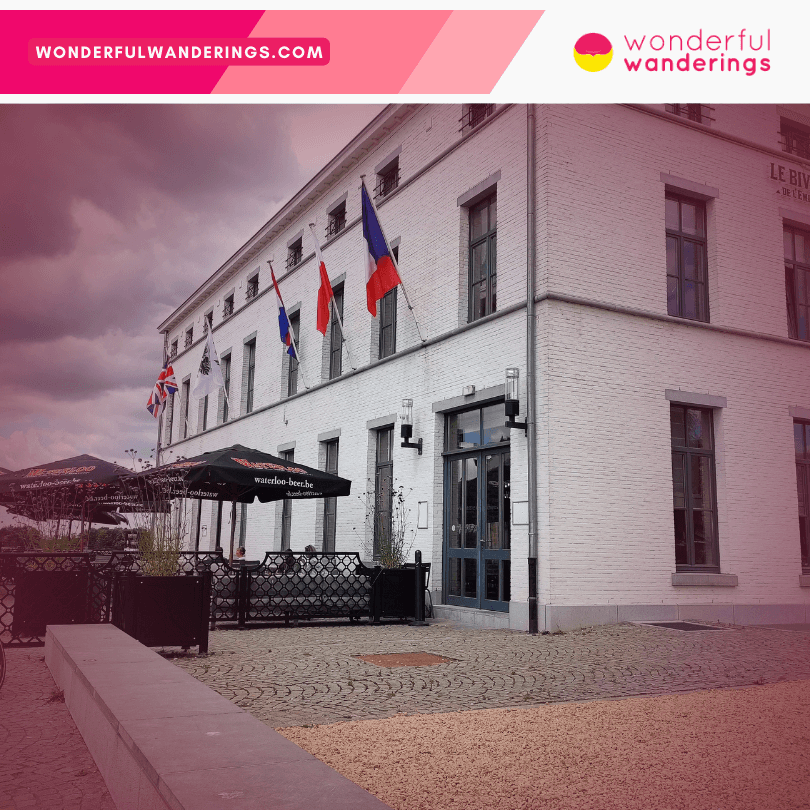
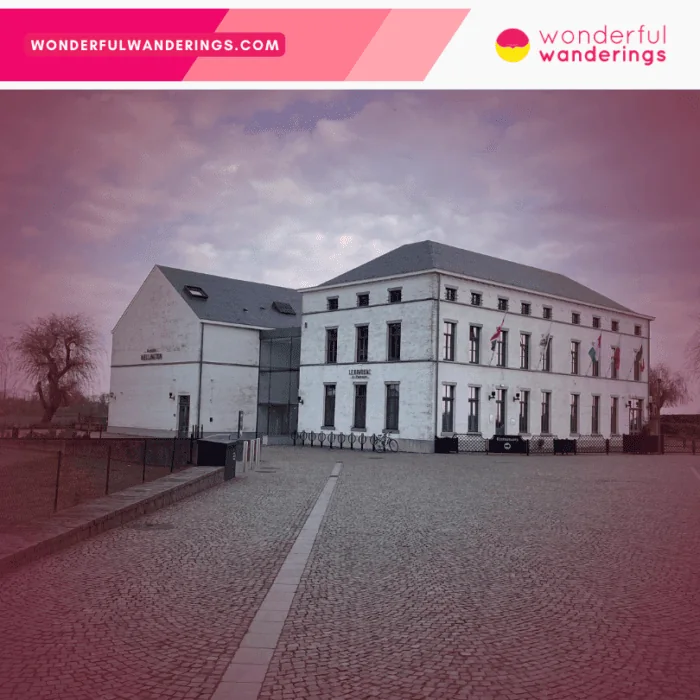
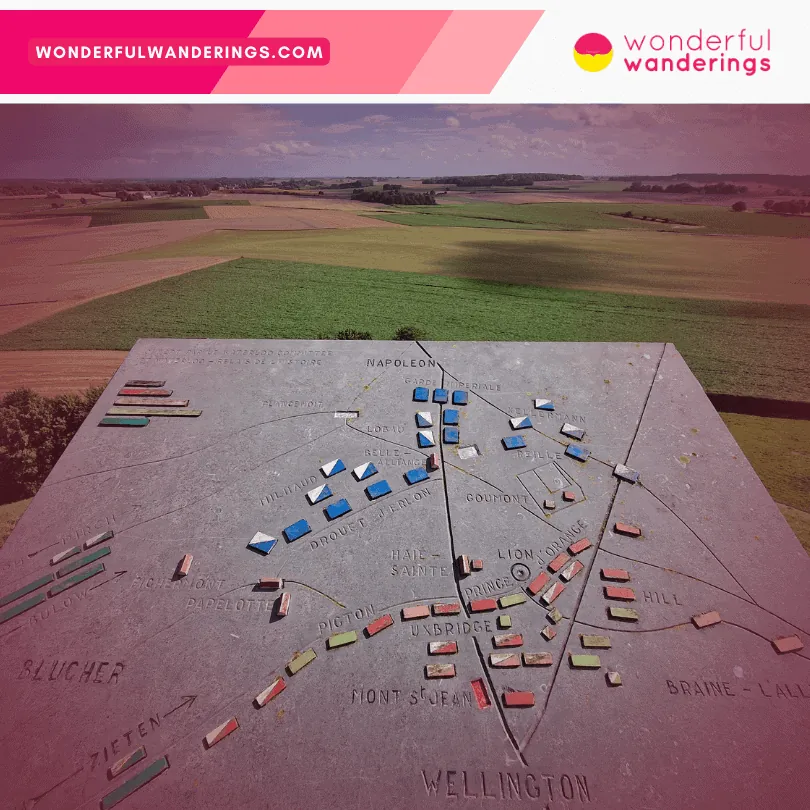
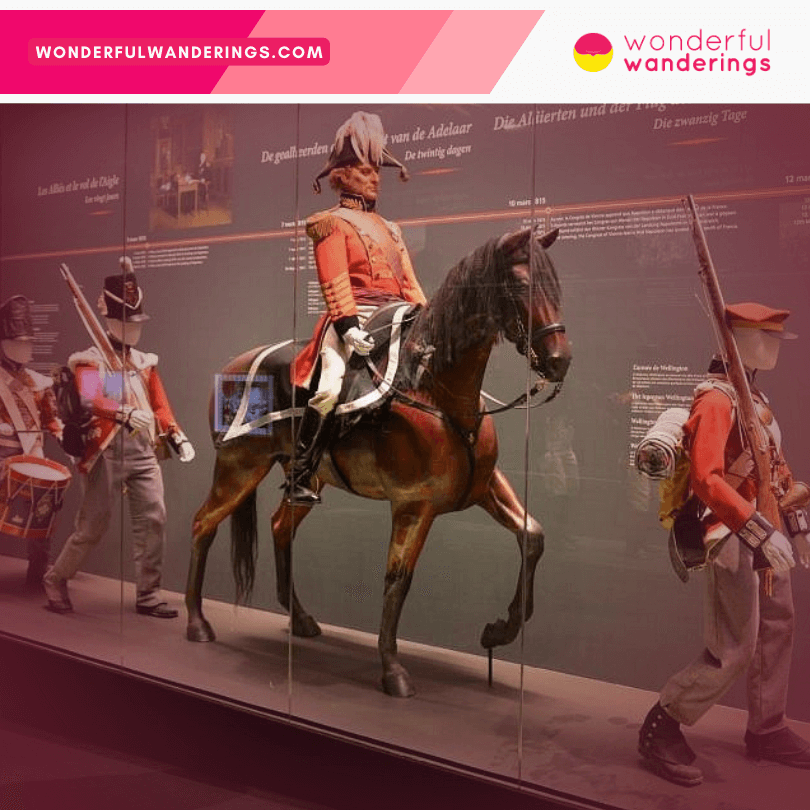
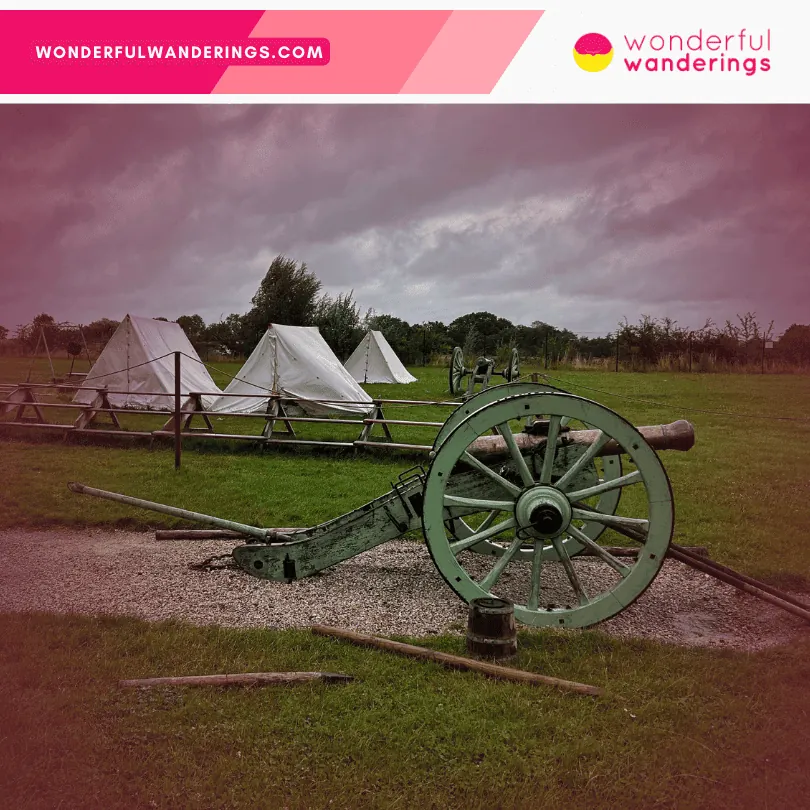
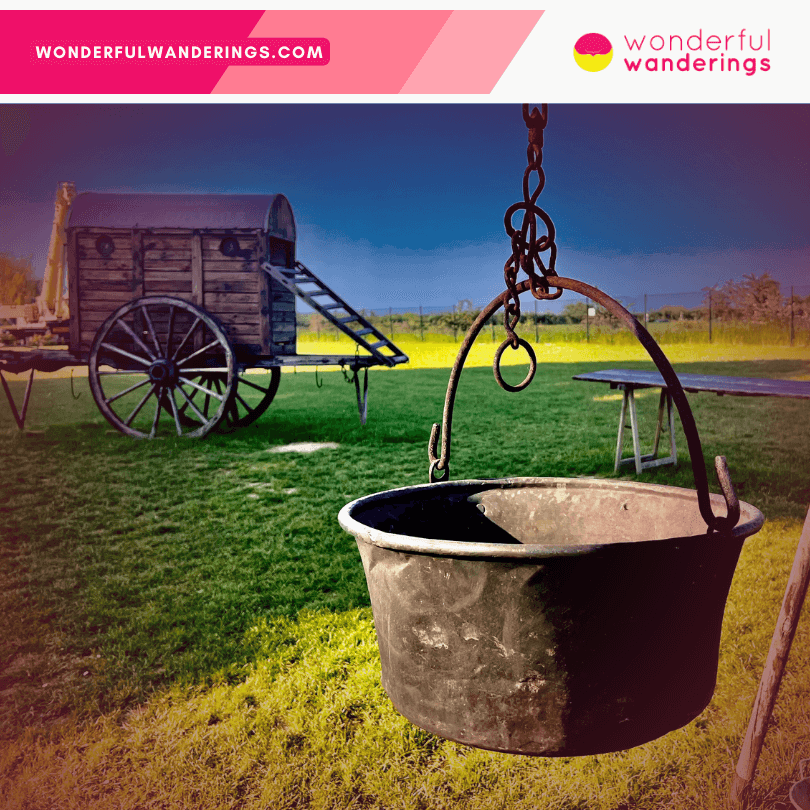
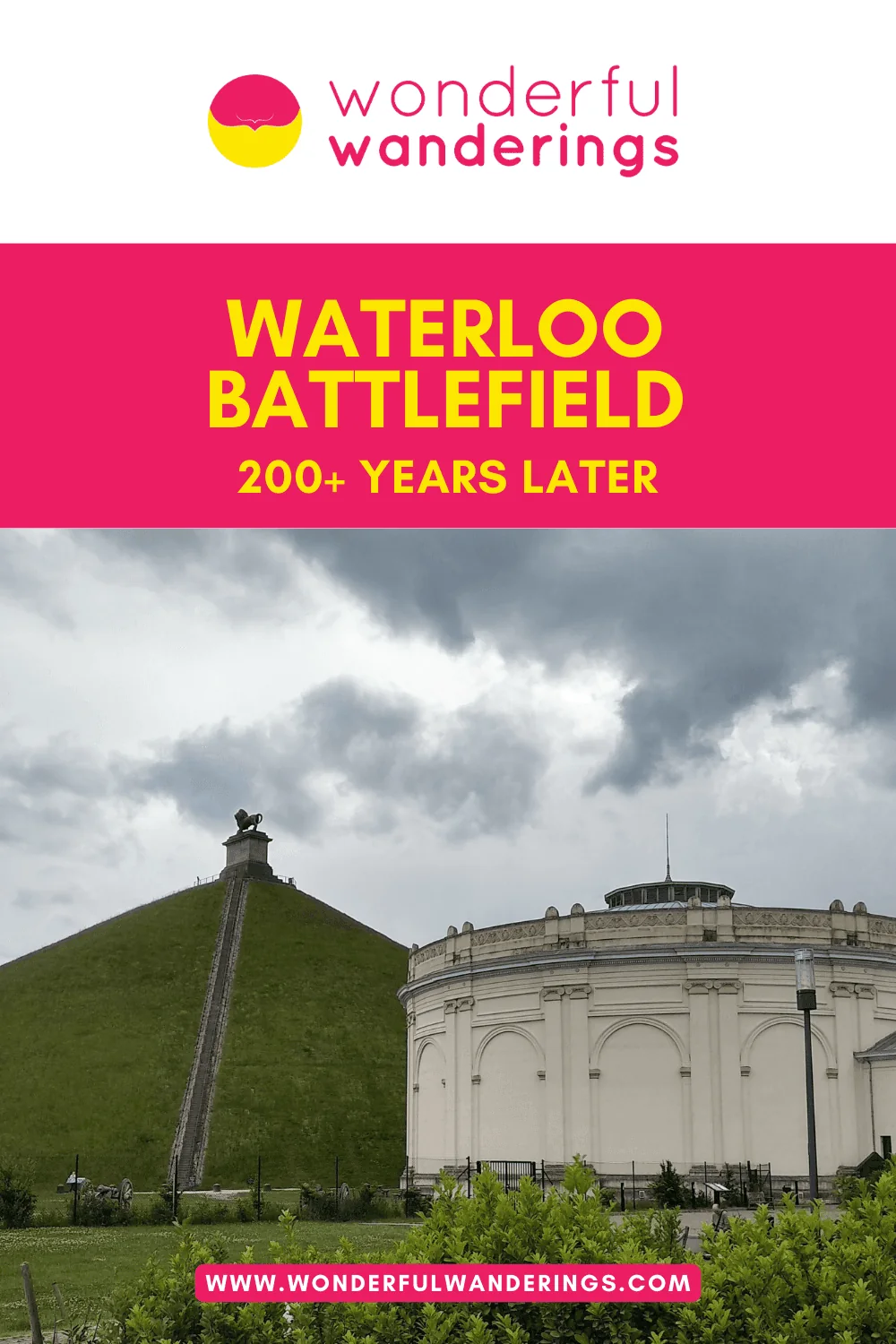

nancy alexander says
I really enjoyed visiting this place. i love history and museums but the most interesting part wad the battle field tour. The audio guide takes you back to 1815 and makes you part of this piece of history.
The Guy @flightsandfrustration.com says
Wow that Lion’s Mound is very steep and tall! Great for a landscape view.
This sounds like a place that would really fascinate me. I have an insatiable knowledge for history and such a notable site as this which was defining in European and maybe global history would be right up my street.
There is one problem though. Ever since I read the title to this post I seem to have the sound of Abba going around in my head. Any ideas why?
Sofie says
Oh yes, it is, unfortunately:)
Thanks, now I’m thinking of the song as well!
Corinne says
Sofie, I’ve got to go to Waterloo, you’ve convinced me.
Sofie says
That’s one of the best comments I could get:-)
David Trower says
I have bough a ticket for the reenactment on Friday. I am coming from the United States, it will be my first time in Europe.
Sofie says
That’s so cool! I hope you will enjoy it. Will you visit some other things in Belgium as well?
David Trower says
I will be doing fun things. I got some ideas off this website.
Sofie says
Happy to read that:)
carl hansen says
Can you do everything in one day or two to see more. I’m thinking of staying in Waterloo and the hotels look fine. I’m arriving from Villers Britenaux then off to Bastoigne so bit of a historical military tour
Sofie says
A day should be enough. The museum in the center is the size of a house. Everything else is next to each other so no need to move around a lot. The new museum, which is the one by the battlefield, is quite big and there’s is a lot of information. If you’re into war history – and it seems you are – you can probably spend a good few hours here. I’d say you could arrive late morning, visit the museum in the center, have lunch somewhere, then go to the new museum, the battlefield etc. That could be a full afternoon. Hope this helps :)